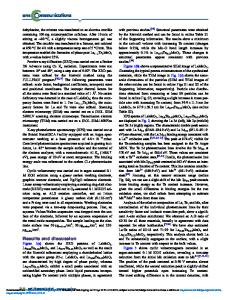Aluminum Doped Silicon Nanocage as High Efficiency Catalysts to Oxygen Reduction Reaction
- PDF / 1,229,875 Bytes
- 6 Pages / 612 x 792 pts (letter) Page_size
- 26 Downloads / 372 Views
minum Doped Silicon Nanocage as High Efficiency Catalysts to Oxygen Reduction Reaction Li Yana, Yingfang Lia, *, Bo Yanga, Wei Gaob, and Meysam Najafic, ** aSchool
of Engineering, Honghe University, Mengzi, 661199 China of Information Science and Technology, Yunnan Normal University, Kunming, 650500 China c Medical Biology Research Center, Kermanshah University of Medical Sciences, Kermanshah, 67149-67346 Iran *e-mail: [email protected] **e-mail: [email protected] bSchool
Received April 26, 2019; revised September 10, 2019; accepted October 14, 2019
Abstract—In the acidic condition the oxygen reduction reaction (ORR) through the aluminum doped silicon nanocage (Al–Si78) is studied. The ORR reactions are examined by theoretical methods and optimum pathways for ORR on Al–Si78 are examined. Results indicated that the Al–Si78 catalyzed the ORR through the LH and ER paths. Calculated parameters displayed that ER and LH paths are optimum pathways for ORR on surface of Al–Si78. Results demonstrated that the Al–Si78 can be considered as high potential catalyst to ORR. Keywords: ORR, nanocage, M06-2X, catalyst, fuel cells DOI: 10.1134/S1023193520060142
INTRODUCTION Generally, platinum catalysts have been used as catalysts of oxygen reduction reaction (ORR) of fuel cells while the platinum compounds have low performance and high costs [1–3]. The carbon nanostructures with low price, high surface area and strong potential to CO endurance have been used as favorable replacements [1, 2]. Recently, doped nanostructures by several heteroatoms have been proposed as catalysts in ORR of fuel cells [3, 4]. The action mechanisms of carbon nanostructures as catalysts of ORR in fuel cells have been investigated [5, 6]. Parsons et al. [7] have indicated that the free energy diagram along the reaction coordinate is a powerful tool to resolve a reaction mechanism. They determined the rate of a reaction by the transition state with highest free energy. Over et al. [8] have investigated chlorine evolution, oxygen evolution reaction and oxygen reduction through ab initio methods. They showed that catalyzed reaction rate was controlled by transition state with the highest free energy and ratedetermining step in ab initio kinetics [8]. The full free energy landscape can either be derived by ab initio theory as done by Exner for chlorine evolution, or by a combined experiment-theory approach, which was introduced by Exner and Over [8–11] on the example of several electrocatalytic key reactions. Koper et al. [10] have investigated the correlation between thermodynamics and kinetics, indicating that thermo-
dynamics is not always a good measure for the kinetics. Hence, to gain unprecedented insights into a reaction mechanism, the inclusion of kinetics is indispensable to derive the full free energy landscape. Over et al. [12] have examined the free energy diagram to discover the rate-determining step of ORR on IrO2 (110) surface in various conditions. They proposed that electron transfer decoupling in the ratedetermining reaction step was im
Data Loading...










